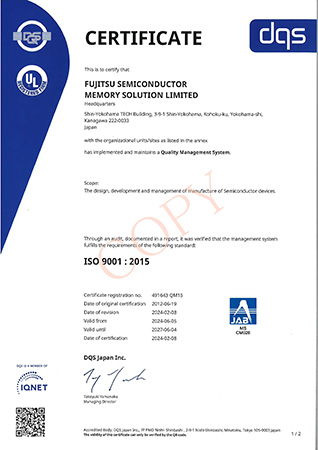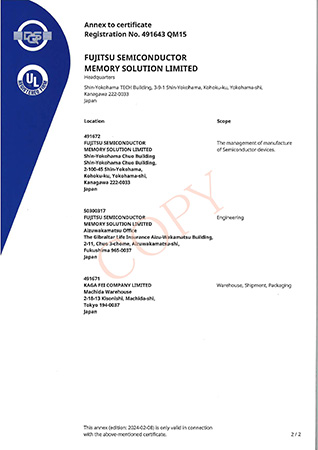Quality and Reliability Assurance
Quality and Reliability
Fujitsu Semiconductor Memory Solution’s LSIs are used in a variety of fields and play an important role in our customers’ products.
We place the highest priority on product quality and reliability, and we are known for high quality and reliability worldwide. We are working to improve quality and reliability even further in terms of people, processes, and products while strengthening cooperation with manufacturing partner companies.
Reliability Scheme
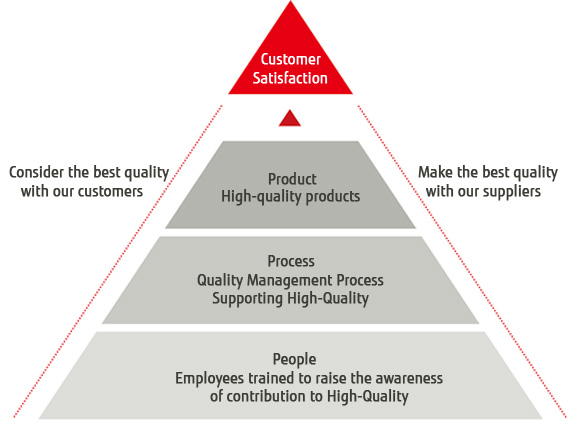
People
- Producing high quality through education of personnel
Not only are our staff members highly skilled in various aspects, they are also dedicated to achieving the highest standards of quality and reliability. We realize this by our educational programs which make each employee to acknowledge the importance of achieving the quality and reliability of end products.
Processes
- High quality built in at every stage
Maintaining optimal conditions during the processes of product planning, design and development, delivery and after-sales support is the key point to stably supplying high-yield and high-quality LSIs. We perform thorough checks based on strict quality standards at every stage of the process to attain these targets.
Products
- High quality suitable for all sectors of society
Our extensive expertise based on continuous development and improvement of FeRAM technology for more than 20 years enables us to release advanced non-volatile memories that meet a variety of customer needs. We seek to contribute to diverse segments of society by providing highly reliable products created from accomplished and optimized memory solution.
Policy
mission:
We build wealthy future with dreams by contributing to the realization of comfortable and secure digital society.
vision:
We achieve autonomous and continuous growth.
We aim self-sustainable and global No.1 company of non-volatile memory provider.
<Quality Policy>
- Committed to provide QCDES.
Q=High Quality, C=Low Cost, D=Delivery,E=Environment,S=Speed - Industry leading product value. (CSP: Cost/Schedule/Performance)
Security, Low Leak FeRAM Technology, NVM Macro - Human resources development.
Quality Assurance System
The Quality Assurance department controls every stage from planning of new product, design, mass-production, to managing customer complaints to supply highly reliable semiconductor products and services to customers.
Our Quality Assurance department functions as the overall center for assuring quality and reliability, and has strong relationships not only with our internal engineering departments but also with the QA dept. at our suppliers.
Quality Assurance System Structure Diagram
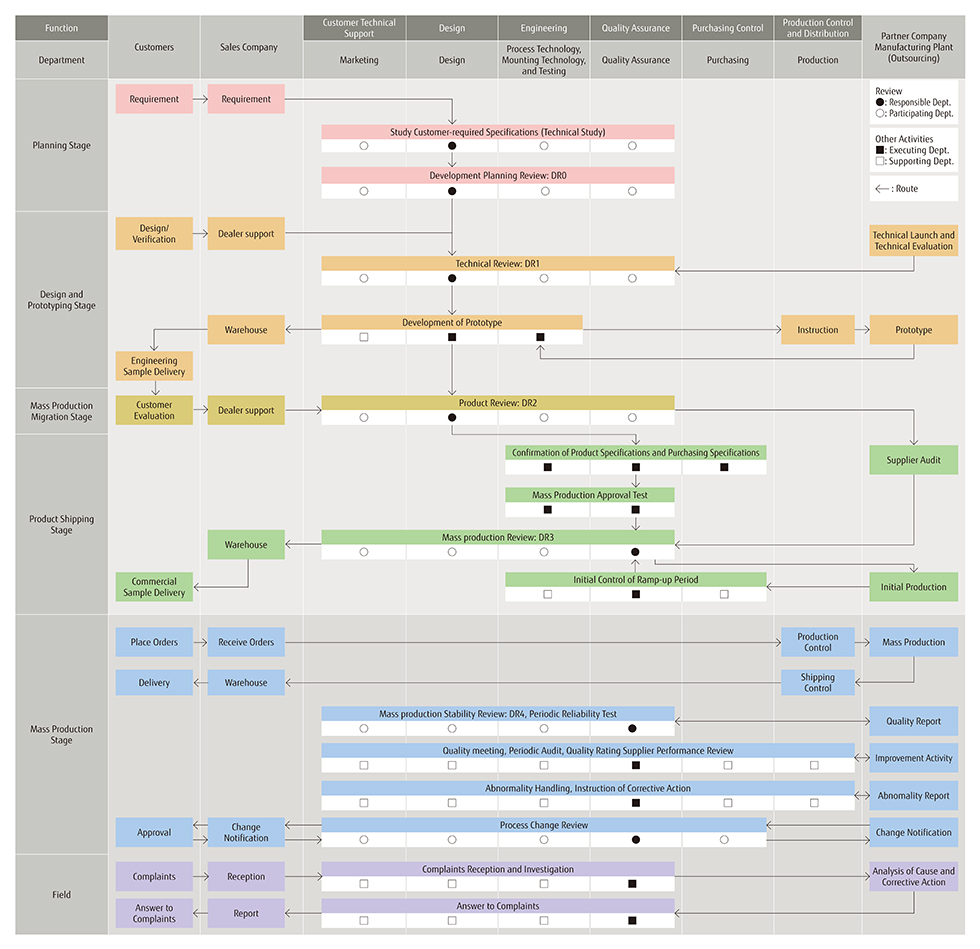
- Design Reviews
- FMEA
- Reliability Tests
- Design Change, Process Change
- Traceability
- Customized Quality Programs to Meet Diverse Customer Requirements
Quality Assurance Program
Quality Assurance Flowchart
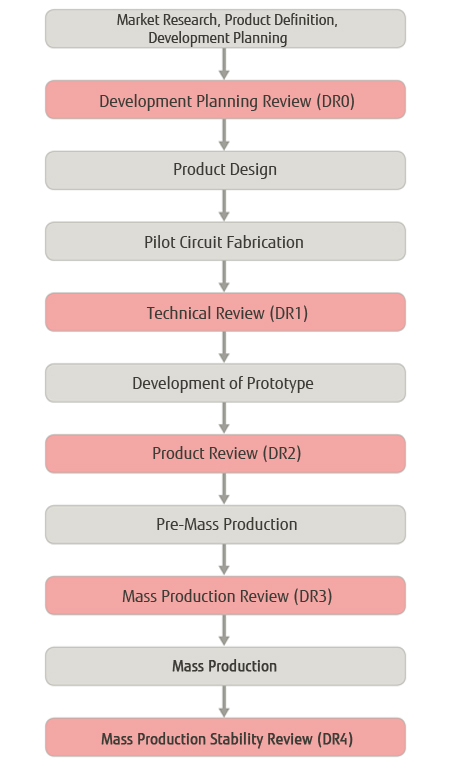
Our company conducts evaluations and examinations of semiconductor devices according to our quality assurance program at every stage from market research and planning to design prototype development and mass production.
Creating quality starts from the planning stage for semiconductor devices. We conduct market research to ascertain and analyze customer requirements, incorporate these into product planning and then apply that to quality.
Continuing from the product-planning stage, we incorporate consistent quality in all stages of design, prototype development and mass production.
Design Reviews
From the time that market research, product planning and development planning are completed until mass production begins, we conduct design reviews at each step of the development stage.
The design review in our Quality Assurance Program is composed of five steps from DR0 to DR4.
| Design Review | Content |
|---|---|
| Development Planning Review (DR0) |
The Development Planning Review evaluates the processes, circuits, materials and equipment to be used for the new product. It also establishes a schedule for DR1, DR2 and DR3. |
| Technical Review (DR1) |
The results of DR0 determine the basic design for the product characteristics and reliability. Pilot circuits are produced for evaluation, and the basic technology is established. The Technical Review examines this basic design to verify that the development technology is appropriate. |
| Product Review (DR2) |
Characteristics, functions and reliability of pilot products are verified at this stage. Conditions and specifications for pilot mass production are determined, and other steps are taken to prepare for mass production. |
| Mass Production Review (DR3) |
Before mass production, product evaluations and Mass Production Approval Tests are conducted on the pre-mass production products. The Mass Production Review confirms the findings of the Mass Production Approval Tests including the specifications and equipment allocations required for mass production, and makes the final decision to begin mass production. |
| Mass Production Stability Review (DR4) |
Review to confirm stability and long-term reliability of production after starting mass production. Implemented about three months after shipping or approximately 30 lots after starting mass production. |
FMEA (Failure Mode and Effects Analysis)
FMEA has been incorporated into our product designs to evaluate the three items including the degree of effect, the degree of occurrence and the degree of detection of failures that can occur and their causes. A risk index (degree of importance) is formed by combining the values recorded for above three items.
Countermeasures are undertaken starting with items having high numerical values. Implementing FMEA allows us to confirm that countermeasures are being implemented for predicted failures, and is useful in making corrections and taking steps for prevention.
Sample of FMEA Sheet
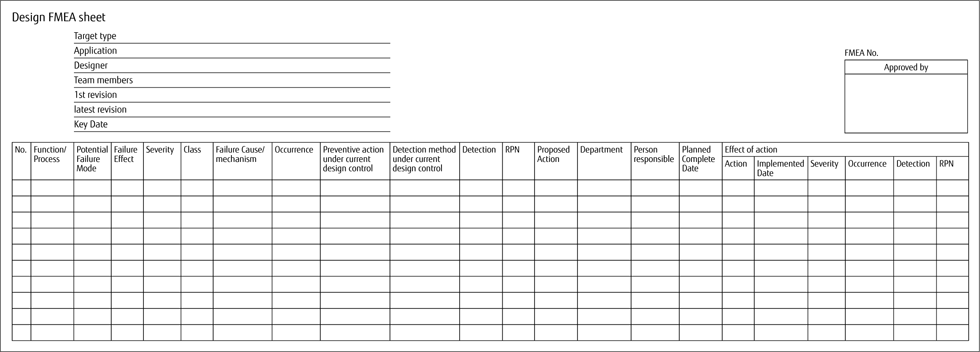
Reliability Tests
Process Qualification Test
To ensure the reliability of newly developed technologies, we conduct process qualification using TEGs (Test Element Groups)* for all fundamental failure modes.
* TEG (Test Element Group): A group of elements used to evaluate and identify failure modes.
| Test Item | Factor | Main Acceleration Factor |
|---|---|---|
| Electromigration | Wiring materials, structure, current density | Current density, temperature |
| Stress Migration | Wiring materials, structure | Temperature, stress |
| Hot Carrier Injection | Transistor structure,distribution of impurities | Electric field |
| Gate Oxide Integrity | Structure, oxide film characteristics | Electric field, temperature |
| Negative Bias Temperature Instability | Transistor structure,oxide film characteristics | Electric field, temperature |
Mass Production Approval Tests
These tests are conducted for mass production approval and include technical factors that affect a product's reliability. The tests also consider new technological factors or newly combined technological factors. We use TEG or representative products that relate to actual products by using grouping method of our products.
| Test Item | Conditions | JEDEC Standard Number | Purpose of Test | New Process Technology Launch | New Assembly Package Technology Launch | |
|---|---|---|---|---|---|---|
| High Temperature Operating Life Test* |
HTOL | 125℃ | JESD22-A108 | Evaluates device durability when operated for long periods under high-temperature environments. | 〇 | △ |
| Temperature Humidity Bias Life Test* |
THB | 85℃, 85%RH | JESD22-A101 | Evaluates device durability when operated for long periods in a high-temperature,high-humidity atmosphere. | 〇 | 〇 |
| Temperature Cycling Test* | TC | -65℃ up to 150℃ | JESD22-A104 | Evaluates device durability in repeated high and low temperature situations. | 〇 | 〇 |
| Highly Accelerated Stress Test |
HAST | 130℃, 85%RH | JESD22-A110 | Evaluates durability when device is stored in a bias-charged state in a high-temperature, high-humidity atmosphere. | 〇 | 〇 |
| Unbiased HAST | UHAST | 130℃, 85%RH | JESD22-A118 | Evaluates durability when device is stored in a high-temperature, high-humidity atmosphere. | 〇 | 〇 |
| Low Temperature Operating Life Test |
LTOL | -55℃ | JESD22-A108 | Evaluates device durability when operated for long periods under low-temperature environments. | 〇 | △ |
| High Temperature Storage Life Test |
HTSL | 150℃ | JESD22-A103 | Evaluates device durability when stored for long periods under high-temperature environments. | 〇 | 〇 |
| Evaluates retention (data retention) characteristics with FeRAM. | 〇 | - | ||||
| Endurance Test | Endurance | Operation ambient temperature |
- | Evaluates durability in repeated writing of data. | 〇 | - |
| Thermal Shock Test | TS | 0℃ up to 100℃ | JESD22-A106 | Evaluates durability in sudden heat changes. | △ | △ |
| Early Life Failure Rate Test | ELFR | 125℃ | JESD74 | Evaluates initial reliability of device use. | △ | - |
| Electrostatic Discharge Sensitivity Test (Human Body Model) |
HBM | - | JS-001 | Evaluates device durability when static electricity discharges are received by human body model. | 〇 | - |
| Electrostatic Discharge Sensitivity Test (Charged Device Model) |
CDM | - | JS-002 | Evaluates device durability when static electricity discharges are received by a device. | 〇 | 〇 |
| IC Latch-up Resistance Test |
LU | - | JESD78 | Evaluates device resistance to latch-up. | 〇 | - |
| Thermal Characterization | - | - | - | Evaluates electrical characteristics under low, room, and high temperatures. | 〇 | △ |
* For Surface mount type package, implements tests by adding thermal stress envisioning surface mounting before test.
Design Change, Process Change
Flowchart of Design Change and Process Change
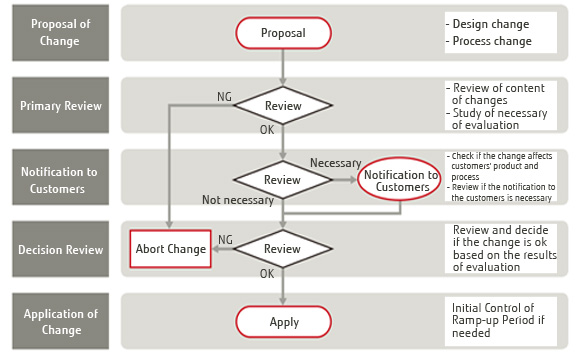
When Design change and / or Process Change are proposed internally, a primary review meeting organized by the QA department and other relevant departments is held to study the changes.
In order to confirm that there are no differences in quality and reliability to our existing products, evaluation and qualification tests are performed if needed. The manager of QA department finally approves the changes before the application.
We notify our customers of changes in advance when we judge the changes could affects the products and / or process of customers from the viewpoint of quality, reliability, electrical characteristics, device dimensions, external appearance, and ease-of-use.
Traceability
Marking Example
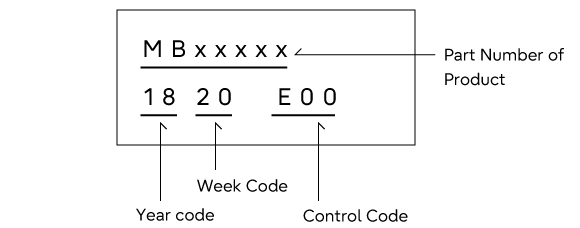
Fujitsu Semiconductor Memory Solution controls manufacturing logs of all devices from the wafer process to assembling, testing, and shipping so that we can trace the manufacturing history when any problem occurs in the market or manufacturing process of a customer.
Manufacturing history of each device can be identified by the marking on each device package.
Customized Quality Programs to Meet Diverse Customer Requirements
Fujitsu Semiconductor Memory Solution has the customized quality assurance programs which can provide higher quality and higher reliability products to meet diverse customer requirements. These optional programs are optimized to automotive applications or similar high-quality requirement applications in some cases.
These products can usually be identified by a specific parts number such as -GS grading.
Following table shows the example of our specific quality assurance programs.
Please contact us for more details of such customized quality programs.
| Items of Requirement | Content of Requirement |
|---|---|
| Reliability Evaluation (Qualification) Level | Support of AEC-Q100 compliance |
| Information on Our Quality Control | Request of PPAP contents supply (FMEA, control plan, MSA, and others) |
| Requirements of Our Suppliers | Requirement of obtaining IATF16949 certification |
| Other Requirements | Request of quality targeted Low FIT rate, low ppm, optional screening |
Collaboration with Suppliers
Collaboration Through 5 Important Factors
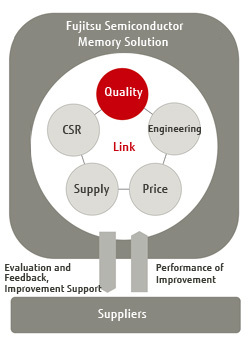
Fujitsu Semiconductor Memory Solution, a design and development company of electronics devices has a strong relationship with suppliers such as wafer manufacturers and package assembly makers. We collaborate to improve our products in terms of quality, engineering, price, stable supply and CSR* in order to satisfy our customers.
* CSR:Corporate Social Responsibility
Selecting and Certifying of Suppliers
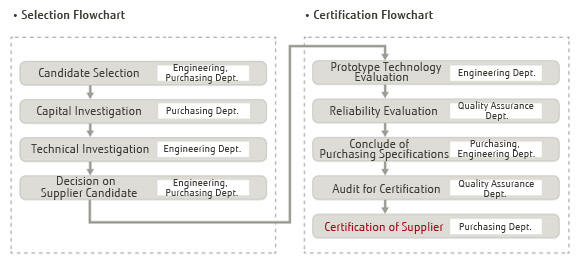
For manufacturing of high-quality products, the suppliers to which we outsource wafer manufacturing, and packaging for our products are very important. Therefore, we carefully decide and certify the suppliers.
First stage is the selection stage. At this stage, we decide candidates for supplier through three steps, candidate selection, a capital investigation, and a technical investigation.
After selecting the candidate, we shift to the second stage, certification stage. At this stage, we can begin to certify the candidate through four-steps, a prototype technology evaluation, a reliability evaluation, conclusion of purchasing specification (including an agreement on Quality Assurance), and finally an audit, for certification.
If the candidate is approved by the audit, we certify the company as a supplier.
Supplier Management at Mass Production
Supplier Management Flowchart
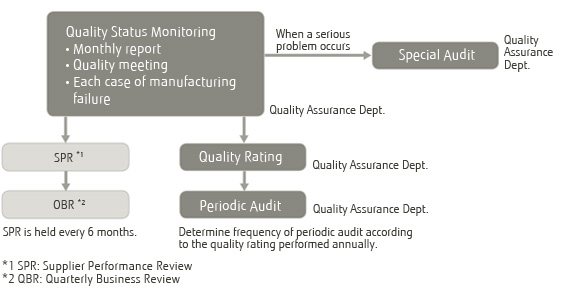
Fujitsu Semiconductor Memory Solution outsources manufacturing of our products to certified suppliers. In controlling mass production at this stage, we conduct continuous monitoring, measurements, and analysis of the supplier through monthly reports, quality meetings, complaint support and abnormal control activities. Furthermore, we evaluate and rate our suppliers quality based on the results of their performance. And also we conduct periodic audits, special audits, and give them feedback.
Customer Support for Quality
Customer Quality Support Diagram

Fujitsu Semiconductor Memory Solution has continued to supply detailed support for product quality to ensure a stable supply of high-quality products.
An example is failure analysis. If any failure by our products occurs at the customer side after shipping, we investigate the failed device to find the root cause. Then we implement countermeasures against the cause, and take corrective action to prevent the same failure recurring. The failure analysis report to the customer includes the above status, the cause of failure, countermeasure, and corrective action etc. We provide feedback internally to improve quality and reliability of products. In addition, Fujitsu Semiconductor Memory Solution responds to customer requests such as providing of quality and reliability data, and cooperating with factory audits.
Failure Analysis
Failure Analysis Flowchart
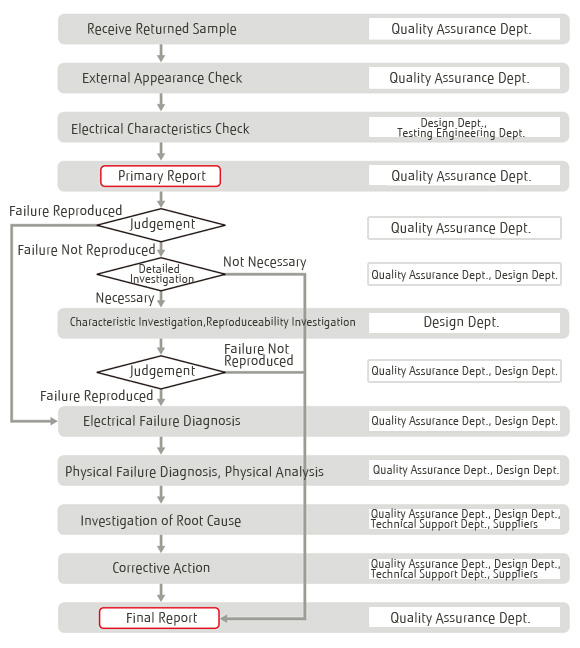
Fujitsu Semiconductor Memory Solution carefully analyzes all products returned from customers as failures. After an initial check on external appearance and electrical characteristics, we investigate the cause of the failure. When we specify the root cause, we implement countermeasures against the cause, and take corrective action to prevent the same failure from recurring.
Fujitsu Semiconductor Memory Solution provides feedback on the failure analysis information to not only our internal engineering Dept. but also suppliers to improve the quality and reliability of the final product.
Quality Management System
Fujitsu Semiconductor Memory Solution acquired the certification of ISO9001 which is the international standard for Quality Management System (QMS).
ISO9001: Certification
| Company Name and Location | ISO Standard Number | Date of Certification | Date of Expiration | Certificate Registration Number | Certification Body |
|---|---|---|---|---|---|
| Fujitsu Semiconductor Memory Solution Limited (Shin-Yokohama TECH Building) | ISO9001-2015 | June 19, 2012 (February 8, 2024) *1 (December 5, 2003) *2 |
June 4, 2027 | 491643 QM15 | DQS |
-
*1Date updated
-
*2Initial date of certification
ISO9001 Certificate
